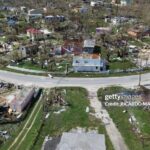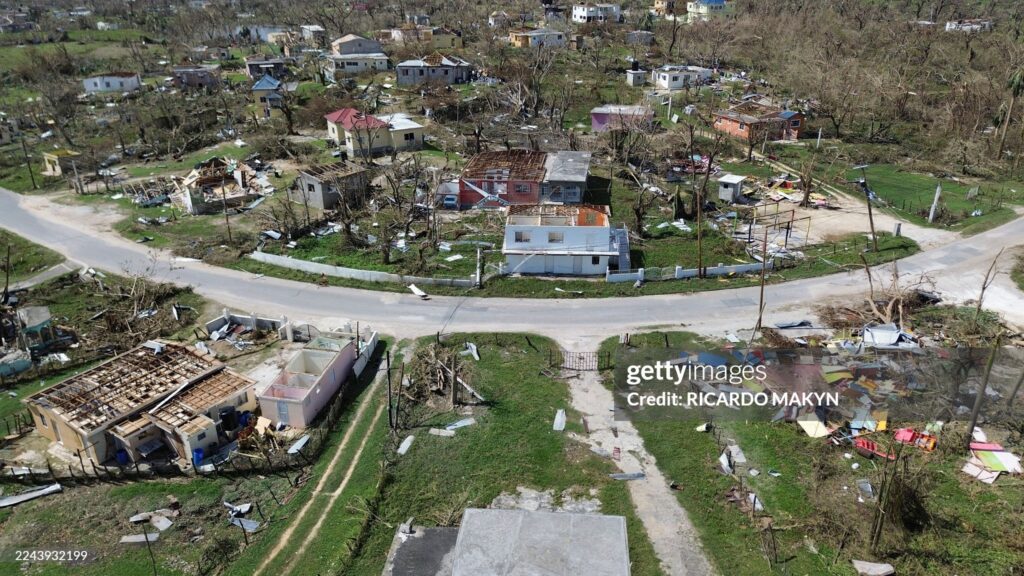
News Americas, NEW YORK, NY, Fri. Nov. 21, 2025: Jamaica now has a clearer picture of the devastation left behind by Hurricane Melissa. According to a new joint assessment by the World Bank and the Inter-American Development Bank, (IDB), the storm caused US$8.8 billion in physical damage – equal to 41% of Jamaica’s 2024 GDP and the costliest hurricane in Jamaica’s recorded history.

This preliminary estimate comes from the Global Rapid Damage Estimation (GRADE) methodology, which analyzes sector-by-sector destruction. The figures do not include broader economic losses, which are expected to be substantial. That means Jamaica’s total recovery need may still approach — or exceed — the US$10 billion figure cited by Jamaican Finance Minister Dr. Nigel Clarke.
The breakdown of physical damage shows the scale of the crisis:
- 41% — Residential buildings
- 33% — Infrastructure (roads, bridges, ports, utilities)
- 21% — Non-residential buildings (businesses, schools, hospitals)
- 5% — Agriculture (though losses to farms and livestock are likely to surge over the long term)
“This disaster demands a fast, coordinated, and evidence-based response,” said IDB Vice President Anabel González. The World Bank echoed that sentiment, reaffirming its readiness to “mobilize its full range of support.”
But even with multilateral assistance, Jamaica faces a difficult truth: the country cannot rebuild its economy on the same fragile foundation that climate change is repeatedly destroying.
State Minister Alando Terrelonge, during field assessments in St. James and St. Elizabeth, stated bluntly that Hurricane Melissa “reflects the growing climate vulnerability of Small Island Developing States, (SIDS),” warning that climate-related disasters pose a “direct threat to life, property, and economic and national security.”
Tourism — Jamaica’s largest foreign exchange earner — is also its most exposed industry:
- Hotels are built on vulnerable coastlines
- Insurance premiums have soared beyond affordability
- Storms wipe out years of investment in hours
- Airline disruptions reduce arrivals
- Tourism jobs vanish instantly after disasters
- U.S. economic uncertainty affects visitor spending
- Cruise lines dominate arrivals but deliver minimal local revenue
Jamaica, like the wider Caribbean, cannot keep rebuilding the same tourism-centric model that collapses every hurricane season.
Melissa proves: Economic diversification is no longer optional — it is a survival strategy.
Given the updated GRADE findings, Jamaica will need a layered, multi-year financing strategy. Below are realistic, responsible pathways — not guarantees — based on global best practices for SIDS and the instruments the World Bank, IDB, CDB, and partners already use.
The World Bank and IDB have already activated some disaster-response instruments, but the agencies publicly confirmed:
“We are ready to mobilize our full range of support.”
This could include:
- expanded IDB resilience loans
- new World Bank climate-resilient infrastructure windows
- targeted CDB emergency programs
- Green Climate Fund adaptation financing
- Japan-funded disaster-risk programs (already tied to GRADE)
These would require new negotiation rounds and multi-year programming.
Jamaica’s diaspora is powerful, high-earning, and deeply connected. A “Rebuild Jamaica 2030 Diaspora Bond” series is one of the most viable tools available. Even modest uptake could raise hundreds of millions.
Beyond CCRIF, Jamaica could structure its own cat or resilience bonds — instruments increasingly used by climate-vulnerable countries to pre-finance future risk.
PPPs can accelerate funding for:
- hospitals
- roads and bridges
- renewable energy
- water and wastewater infrastructure
- coastal protection
- telecom upgrades
This eases fiscal pressure while modernizing infrastructure.
Especially strong opportunities exist in:
- Resilient housing reconstruction
- Climate-smart agriculture and agri-tech
- Tourism resilience retrofitting
- Digital and creative services
- Renewable energy and microgrid expansion
These areas align perfectly with donor priorities for SIDS.
Not guaranteed — but achievable with coordination, diplomacy, and clear investment frameworks. The remaining gap could be covered through domestic reprioritization, private capital, and phased rebuilding.
Here is where we fold in the “look beyond tourism” message grounded in the official climate vulnerability framing:
Elevated homes, stronger building codes, underground utilities, seawalls, river training, mangrove restoration.
Greenhouses, aquaculture, drought-resistant crops, digital farming — reducing Jamaica’s food-import vulnerability.
Animation, fintech, creative industries, remote services — sectors that continue operating even after storms.
Solar microgrids, wind, storage, resilient energy hubs — reducing reliance on imported fuel.
ECLAC’s new data shows Jamaica now faces lower U.S. tariffs than Asia — a strategic opening for exports.
Hurricane Melissa marks a turning point. Jamaica must rebuild — but not back to what it was. The Government’s early damage assessments and calls from Minister Terrelonge make the message clear: Jamaica must rebuild safer, stronger, and more climate-resilient — and it must diversify beyond tourism to survive the next generation of storms.
British Caribbean News


